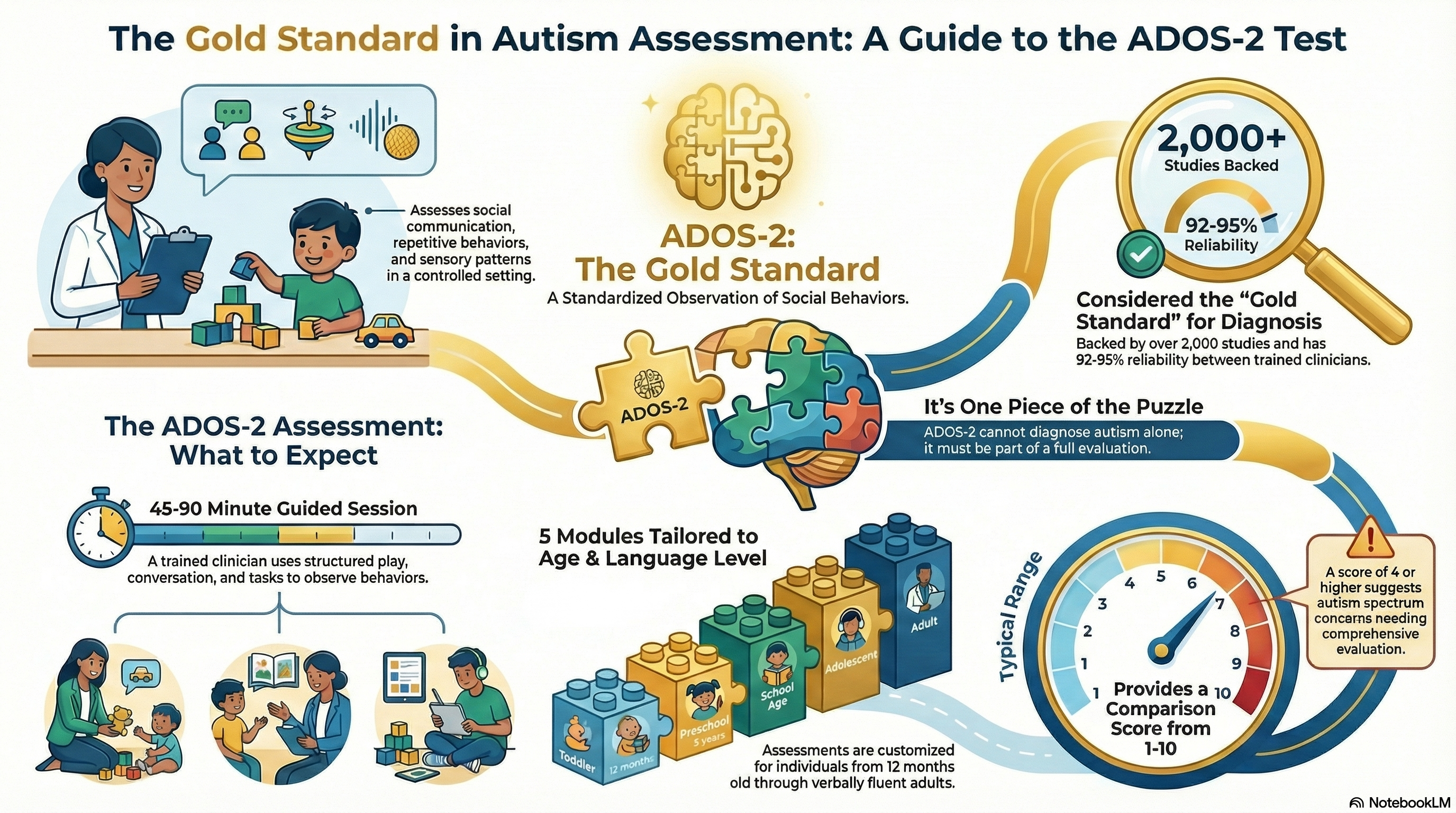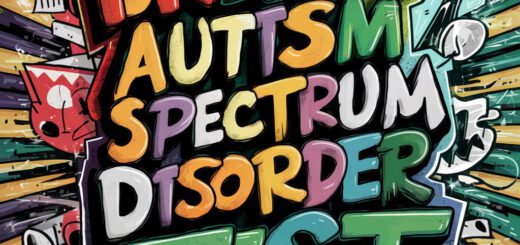Understanding the Autism Diagnostic Observation Schedule (ADOS)

TL;DR: The Autism Diagnostic Observation Schedule (ADOS-2) is the gold standard tool for diagnosing autism spectrum disorder in 2025. It uses structured activities across 4 modules tailored to different ages and verbal abilities. While highly reliable, ADOS cannot diagnose autism alone. It’s part of a comprehensive evaluation. This includes developmental history and parent interviews. The assessment takes 45-90 minutes and must be administered by trained professionals. Key benefits include standardized scoring and age-appropriate modules, but limitations include single-setting observation and potential cultural bias.
- What is the Autism Diagnostic Observation Schedule (ADOS)?
- How Does ADOS Work?
- Key Components of ADOS
- Why is ADOS Important?
- ADOS Modules and Age Groups
- ADOS Assessment Duration and Process
- ADOS Scoring and Interpretation
- ADOS vs Other Autism Tests (2025 Comparison)
- Strengths and Limitations of ADOS-2
- Real-Life ADOS Examples by Module
- ADOS Cost and Insurance Coverage (2025)
- Finding ADOS-Certified Professionals
- Frequently Asked Questions About ADOS-2 (2025)
- What is the Autism Diagnostic Observation Schedule (ADOS) and why is it considered the gold standard?
- How long does an ADOS assessment take and what should I expect?
- Can ADOS diagnose autism by itself, or are other tests needed?
- Is ADOS suitable for adults, and how accurate is it for late diagnosis?
- How much does ADOS cost and is it covered by insurance in 2025?
- What’s different about ADOS-2 in 2025 compared to earlier versions?
- How do I prepare my child for an ADOS assessment?
- Can I request a specific ADOS module, or does the clinician decide?
- What happens if ADOS results are inconclusive or borderline?
- How does ADOS compare to online autism tests and screening tools?
- Where can I find reliable information about autism testing and ADOS resources?
- Professional Resources and Training
Updated for 2025: Autism awareness and diagnostic practices continue to evolve. The Autism Diagnostic Observation Schedule (ADOS-2) remains a cornerstone for reliable clinical assessment. It is the gold standard for diagnosing autism spectrum disorder (ASD) across all age groups. The recent 2025 updates emphasize culturally sensitive scoring. They include improved modules for minimally verbal individuals. Additionally, there is broader integration with complementary tools like the SRS-2 (Social Responsiveness Scale), M-CHAT-R, and Vineland Adaptive Behavior Scales.
This comprehensive guide explores how ADOS-2 works, what to expect during testing, and the latest 2025 diagnostic standards. We will compare ADOS with other popular autism assessment tools. We will also provide practical insights for parents, clinicians, and adults seeking diagnosis. These insights are based on today’s evidence-based practices.
Autism Spectrum Disorder (ASD) is a neurodevelopmental condition affecting communication, social interaction, and behavior patterns. Unlike medical conditions with definitive biomarkers, ASD diagnosis relies on comprehensive behavioral assessments. The ADOS-2 provides the most standardized and research-validated approach to autism evaluation available in 2025.

What is the Autism Diagnostic Observation Schedule (ADOS)?
The Autism Diagnostic Observation Schedule (ADOS-2) is standardized and semi-structured. It is an assessment protocol designed to evaluate autism spectrum behaviors across the lifespan. ADOS-2 was developed by Dr. Catherine Lord and colleagues. It focuses on observing social communication. The evaluation also targets restricted and repetitive behaviors and sensory processing patterns in controlled yet naturalistic settings.
As the most widely used autism diagnostic tool globally, ADOS-2 provides clinicians with objective criteria for identifying ASD traits. The assessment has undergone extensive validation studies. More than 15,000 research participants have contributed to its reliability. This ensures its validity across diverse populations.
How Does ADOS Work?
ADOS-2 employs a series of structured activities and social interaction scenarios designed to elicit behaviors characteristic of autism spectrum disorders. The assessment creates standardized opportunities for social communication while allowing natural behavior patterns to emerge.
During the 45-90 minute session, trained clinicians present age-appropriate tasks. These tasks include social games and conversation prompts. They also involve imaginative play scenarios and problem-solving activities. The examiner documents specific behaviors using standardized coding criteria, ensuring consistency across different evaluators and settings.
Key Components of ADOS
- Social Communication Assessment: Evaluates both verbal and nonverbal communication skills, including joint attention, gesture use, facial expressions, and conversational reciprocity.
- Social Interaction Evaluation: Assesses social engagement patterns, including eye contact, social smiling, turn-taking abilities, and relationship quality with the examiner.
- Play and Imagination Skills: For younger children, examines symbolic play, creativity, toy engagement patterns, and imaginative scenarios.
- Restricted and Repetitive Behaviors: Documents stereotyped movements, sensory interests, ritualistic behaviors, and resistance to change.
- Sensory Processing Patterns: In 2025, there will be increased attention to hyper- and hyposensitivity to sensory stimuli. This includes auditory, visual, and tactile processing differences.
Why is ADOS Important?
- Evidence-Based Reliability: ADOS-2 demonstrates inter-rater reliability of 0.92-0.95, meaning different trained professionals achieve consistent results when assessing the same individual.
- Cross-Cultural Validity: 2025 updates include culturally responsive scoring algorithms. These updates also feature diverse normative samples to reduce diagnostic bias across ethnic and socioeconomic backgrounds.
- Lifespan Applicability: Modules accommodate individuals from 12 months through adulthood. They support both early intervention. Late diagnosis scenarios are increasingly common in 2025.
- Research Foundation: Over 2,000 peer-reviewed studies validate ADOS effectiveness, making it the most scientifically supported autism assessment tool available.
- Treatment Planning Support: Results directly inform individualized education programs (IEPs). They guide behavioral interventions and therapeutic goals based on specific strength and challenge areas identified.
ADOS Modules and Age Groups
ADOS-2 includes five specialized modules tailored to different developmental and communication levels, ensuring appropriate assessment regardless of age or verbal ability:
- Toddler Module: Ages 12-30 months with minimal expressive language. Focuses on early social communication markers, joint attention, and sensory responses.
- Module 1: Individuals with little to no phrase speech. Emphasizes nonverbal communication, social engagement, and play-based assessments.
- Module 2: Those using phrase speech but not yet verbally fluent. Combines structured play activities with simple conversational tasks.
- Module 3: Verbally fluent children and young adolescents. Incorporates storytelling, conversation, and social problem-solving scenarios.
- Module 4: Verbally fluent adolescents and adults. Features sophisticated social communication tasks and discussions about relationships, emotions, and daily experiences.
ADOS Assessment Duration and Process
A complete ADOS-2 evaluation typically requires 45-90 minutes, depending on the module selected and individual responsiveness. The assessment follows a structured sequence:
- Pre-Assessment Phase (10-15 minutes): Clinician reviews background information, selects appropriate module, and establishes rapport.
- Structured Activities (30-60 minutes): Administration of standardized tasks with real-time behavioral coding.
- Post-Assessment Scoring (15-30 minutes): Detailed review and scoring of observed behaviors using ADOS-2 algorithms.
- Results Integration (varies): Combination with other assessment data including developmental history, parent interviews (ADI-R), and cognitive testing.
ADOS Scoring and Interpretation
ADOS-2 employs a sophisticated scoring system that generates multiple diagnostic indicators:
Comparison Score: Ranges from 1-10, with higher scores indicating greater likelihood of ASD. Scores of 4 and above suggest autism spectrum concerns warranting comprehensive evaluation.
Domain Scores: Separate measurements are provided for Social Affect (SA). They are also provided for Restricted and Repetitive Behaviors (RRB). This separation allows clinicians to identify specific areas of challenge and strength.
Severity Metrics: 2025 updates include refined severity indicators. These help distinguish between requiring support, requiring substantial support, and requiring very substantial support classifications. This is per DSM-5-TR criteria.
Critical to remember: ADOS-2 results must be interpreted within the context of a comprehensive evaluation. This includes developmental history, cognitive assessment, adaptive behavior measures, and clinical observation across multiple settings. No single tool, including ADOS, can diagnose autism independently.
ADOS vs Other Autism Tests (2025 Comparison)
Understanding how ADOS-2 compares to other autism assessment tools helps families make informed decisions about evaluation approaches:
ADOS-2 vs M-CHAT-R/F: While M-CHAT-R serves as an excellent screening tool for toddlers (16-30 months), ADOS-2 provides comprehensive diagnostic assessment. M-CHAT takes 5 minutes; ADOS requires 45-90 minutes with trained professionals.
ADOS-2 vs SRS-2 (Social Responsiveness Scale): SRS-2 relies on parent/teacher ratings across multiple settings, while ADOS provides direct clinical observation. Best practice in 2025 combines both tools for comprehensive evaluation.
ADOS-2 vs ADI-R (Autism Diagnostic Interview-Revised): ADI-R focuses on developmental history through a parent interview. This interview lasts for 2-3 hours. ADOS observes current behaviors directly. Gold standard diagnosis typically includes both assessments.
ADOS-2 vs CARS-2 (Childhood Autism Rating Scale): CARS-2 provides quicker screening (20-30 minutes). However, it lacks the depth and standardization of ADOS-2. ADOS remains preferred for formal diagnosis.
Strengths and Limitations of ADOS-2
Key Strengths of ADOS-2 in 2025:
- Standardized Administration: Consistent protocols ensure reliable results across different clinicians and settings
- Research Validation: Extensive evidence base with over 15,000 participants validates effectiveness across diverse populations
- Developmental Sensitivity: Modules accommodate wide range of ages and abilities from toddlers through adults
- Cultural Responsiveness: 2025 updates include improved scoring algorithms reducing cultural bias
- Treatment Relevance: Results directly inform intervention planning and goal setting
Acknowledged Limitations:
- Single Setting Observation: Behaviors may not represent typical functioning across different environments
- Potential for Masking: High-functioning individuals may camouflage autistic traits during assessment, particularly affecting late diagnosis accuracy
- Training Requirements: Requires specialized certification and ongoing training, limiting availability of qualified assessors
- Cultural Considerations: Despite improvements, some cultural nuances in social communication may still affect scoring accuracy
- Cost and Accessibility: Comprehensive assessment can be expensive and may not be covered by all insurance plans
Real-Life ADOS Examples by Module
Example 1: Young Child with Limited Speech (Module 1)
Patient Profile: Maya, age 3 years, uses single words occasionally but primarily communicates through gestures and vocalizations.
ADOS-2 Tasks: Response to Name, Bubble Play, Anticipation of Routine with Objects, Responsive Social Smile, and Functional and Symbolic Imitation.
Key Observations:
- Social Communication: Maya makes limited eye contact, shows minimal joint attention behaviors, and rarely initiates social interaction
- Play Patterns: Engages in repetitive manipulation of objects rather than functional or symbolic play
- Sensory Processing: Shows intense fascination with spinning wheels on toy cars, demonstrates tactile defensiveness with certain textures
- Communication: Does not respond consistently to name calling, limited gesture use for requesting
Diagnostic Outcome: Comparison Score of 7, indicating autism spectrum disorder with recommendations for early intensive behavioral intervention and speech-language therapy.
Example 2: Verbally Fluent Child (Module 3)
Patient Profile: Alex, age 9, demonstrates age-appropriate vocabulary and grammar but struggles with social communication in school settings.
ADOS-2 Tasks: Construction Task, Make-Believe Play, Joint Interactive Play, Demonstration Task, and Description of a Picture.
Key Observations:
- Conversation Skills: Provides detailed information but struggles with conversational reciprocity, tendency to monologue about preferred topics
- Nonverbal Communication: Limited eye contact during interaction, minimal facial expression changes, restricted gesture use
- Social Understanding: Difficulty reading examiner’s social cues, literal interpretation of figurative language
- Flexibility: Shows distress when routine activities are modified, rigid adherence to rules during play
Diagnostic Outcome: Comparison Score of 6, supporting ASD diagnosis with recommendations for social skills training and school-based accommodations.
Example 3: Adult with ASD Traits (Module 4)
Patient Profile: Jordan, age 28, seeking late diagnosis after recognizing autism traits in personal relationships and workplace interactions.
ADOS-2 Tasks: Conversation and Reporting, Emotions, Social Difficulties and Annoyance, Friends and Marriage, and Loneliness.
Key Observations:
- Social Reciprocity: Demonstrates intellectual understanding of social rules but struggles with intuitive social responses
- Emotional Expression: Limited range of facial expressions, difficulty modulating voice tone for emotional content
- Relationship Insights: Describes social relationships in analytical rather than emotional terms, reports chronic social exhaustion
- Sensory Experiences: Details specific sensory preferences and aversions affecting daily functioning
Diagnostic Outcome: Comparison Score of 5, confirming ASD with recommendations for workplace accommodations, social skills coaching, and partner/family education.
ADOS Cost and Insurance Coverage (2025)
Typical ADOS-2 Assessment Costs:
- Private Practice: $800-$2,500 for comprehensive evaluation including ADOS-2
- Hospital-Based Clinics: $1,200-$3,000 depending on additional assessments included
- University Training Clinics: $400-$1,000 with supervised graduate students
- Community Mental Health Centers: $200-$800 with sliding scale options available
Insurance Coverage in 2025: Most major insurance providers now cover autism diagnostic evaluations under mental health benefits. The TRICARE Autism Care Demonstration and Affordable Care Act provisions have expanded coverage significantly. However, coverage varies by plan, and some insurers require pre-authorization or referrals from primary care physicians.
Financial Assistance Options: Autism Speaks maintains a directory of grant programs. Organizations like The Autism Society offer financial assistance for diagnostic evaluations. Local Arc chapters also provide similar support.
Finding ADOS-Certified Professionals
Locating qualified ADOS-2 administrators requires verifying proper certification and experience:
Professional Qualifications to Verify:
- ADOS-2 Research Training: Completion of official training workshops through Western Psychological Services
- Clinical Experience: Minimum 2-3 years conducting autism evaluations
- Professional Licensure: Psychologists, psychiatrists, or licensed clinicians with autism specialization
- Continuing Education: Recent training in 2025 ADOS-2 updates and cultural considerations
Where to Find Certified Professionals:
- Autism Speaks Provider Directory: Searchable database of autism specialists by location
- Psychology Today: Filter for autism spectrum disorder specialization and ADOS experience
- University Medical Centers: Often have autism specialty clinics with ADOS-trained staff
- Children’s Hospitals: Developmental pediatrics departments typically offer comprehensive autism evaluation
- State Autism Resources: Many states maintain directories of qualified autism diagnosticians
Frequently Asked Questions About ADOS-2 (2025)
What is the Autism Diagnostic Observation Schedule (ADOS) and why is it considered the gold standard?
The ADOS-2 is a standardized behavioral assessment that observes autism-related behaviors in structured settings. It’s considered the gold standard because it has the strongest research validation (over 2,000 studies), demonstrates 92-95% inter-rater reliability, and provides objective scoring criteria. Unlike other tools that rely on parent reports or brief screenings, ADOS offers direct clinical observation of core autism features including social communication, repetitive behaviors, and sensory processing patterns.
How long does an ADOS assessment take and what should I expect?
ADOS-2 assessments typically require 45-90 minutes depending on the module selected. The process includes structured activities like storytelling, conversation, play scenarios, and social interaction tasks. Your clinician will select age-appropriate activities and document specific behaviors in real-time. The assessment feels more like guided play or conversation rather than formal testing, which helps elicit natural behavioral responses.
Can ADOS diagnose autism by itself, or are other tests needed?
ADOS-2 cannot diagnose autism independently. Best practice requires comprehensive evaluation including developmental history (often using ADI-R interviews), cognitive testing, adaptive behavior assessment (like Vineland scales), and medical examination. The combination of ADOS direct observation with parent-reported developmental history provides the most accurate diagnostic picture. Think of ADOS as providing the “current behavior snapshot” while other tools give historical and contextual information.
Is ADOS suitable for adults, and how accurate is it for late diagnosis?
Yes, Module 4 of ADOS-2 is specifically designed for verbally fluent adolescents and adults. However, adult diagnosis can be more complex due to learned masking strategies and compensatory skills developed over time. The 2025 updates include improved sensitivity for detecting subtle autism traits in adults. Many clinicians combine ADOS with adult-specific tools like the AQ (Autism Quotient) and detailed life history interviews for most accurate late-diagnosis assessment.
How much does ADOS cost and is it covered by insurance in 2025?
ADOS evaluations typically cost $800-$2,500 depending on setting and additional assessments included. Most major insurance providers now cover autism diagnostic evaluations under mental health benefits, particularly following ACA requirements. However, coverage varies by plan – some require pre-authorization or primary care referrals. University training clinics often offer lower-cost options ($400-$1,000), and organizations like Autism Speaks maintain financial assistance directories.
What’s different about ADOS-2 in 2025 compared to earlier versions?
The 2025 ADOS-2 updates emphasize culturally responsive scoring to reduce diagnostic bias across ethnic backgrounds, improved algorithms for minimally verbal individuals, and better integration with complementary tools like SRS-2 and M-CHAT-R. New research has also enhanced sensitivity for detecting autism in girls and women, addressing historical underdiagnosis in these populations. Training now includes modules on recognizing masking behaviors and cultural variations in social communication.
How do I prepare my child for an ADOS assessment?
Keep your child well-rested and comfortable on assessment day. Explain that they’ll be doing fun activities with a professional – no studying or preparation needed. Bring comfort items if helpful, and inform the clinician about any recent stressors or changes in routine that might affect behavior. Most importantly, ADOS is designed to capture natural behaviors, so authenticity is more valuable than “good behavior.” The assessment environment is structured to be engaging and low-pressure.
Can I request a specific ADOS module, or does the clinician decide?
The clinician selects the appropriate module based on your child’s current language and developmental level, not chronological age. This decision is based on pre-assessment information and initial interaction. Module selection is crucial for accurate results – using an inappropriate module can lead to invalid scores. Trust your clinician’s expertise in module selection, as they’re trained to identify the best fit for obtaining reliable behavioral samples.
What happens if ADOS results are inconclusive or borderline?
Borderline ADOS results (comparison scores of 4-6) require careful interpretation within the full evaluation context. Some individuals may show autism traits but not meet full diagnostic criteria, leading to considerations of broader autism phenotype or other developmental conditions. In such cases, clinicians often recommend follow-up assessment after 6-12 months, particularly for young children whose development is still emerging, or additional specialized testing to clarify the diagnostic picture.
How does ADOS compare to online autism tests and screening tools?
Online autism tests and brief screening tools like M-CHAT-R serve as helpful initial indicators but cannot replace comprehensive clinical assessment. ADOS provides standardized direct observation by trained professionals, while online tests rely on self-reporting, which can be affected by lack of self-awareness or social desirability bias. However, positive results on reputable online screenings (like the AQ or SRS-2) can be valuable in prompting professional evaluation and providing supporting information for clinicians.
Where can I find reliable information about autism testing and ADOS resources?
Visit 101Autism.com for evidence-based guides on autism testing, diagnostic processes, and family resources. The Autism Research Institute (autism.org) provides scientific updates, while Autism Speaks maintains provider directories and financial assistance information. For professional training resources, Western Psychological Services offers official ADOS-2 certification programs. Always verify that online information comes from reputable sources with clinical or research credentials.
Conclusion
The Autism Diagnostic Observation Schedule (ADOS-2) remains the most reliable tool for diagnosing autism spectrum disorder in 2025. It is the most scientifically validated tool available. While not a standalone diagnostic instrument, its standardized approach provides essential behavioral observations. These observations, when combined with comprehensive developmental history and clinical assessment, enable accurate autism identification across the lifespan.
Understanding ADOS-2’s capabilities and limitations empowers families to make informed decisions about autism evaluation. Whether seeking early diagnosis for a toddler, ADOS-2 provides an objective and evidence-based assessment foundation. It also offers a reliable assessment when pursuing late-life assessment as an adult. This foundation is necessary for accessing appropriate supports, interventions, and services.
For families beginning the autism evaluation journey, remember that diagnosis is just the first step. It helps in understanding and supporting your loved one’s unique strengths and challenges. Insights from a comprehensive assessment, including ADOS-2, guide the creation of a fulfilling life. This supportive life is within the autism community.
Professional Resources and Training
- ADOS-2 Training and Certification: Western Psychological Services offers official training programs for professionals seeking ADOS-2 certification. Website: wpspublish.com
- Autism Research Institute (ARI): Provides evidence-based resources, research updates, and professional development opportunities. Website: autism.org
- International Society for Autism Research (INSAR): Leading scientific organization promoting autism research and evidence-based practice. Website: autism-insar.org
- Autism Speaks Professional Resources: Comprehensive toolkit for clinicians including diagnostic guidelines and assessment resources. Website: autismspeaks.org/professionals
- American Academy of Pediatrics Autism Toolkit: Evidence-based resources for pediatricians and primary care providers. Website: aap.org
- National Autistic Society Professional Development: UK-based training programs with international applicability. Website: autism.org.uk/professionals
- Association for Behavior Analysis International (ABAI): Professional organization providing autism intervention training and certification. Website: abainternational.org
- Autism Science Foundation: Supports autism research and provides science-based resources for professionals and families. Website: autismsciencefoundation.org
- Local University Autism Centers: Many universities offer specialized training, research opportunities, and continuing education in autism assessment and intervention.
- State Autism Resource Centers: State-funded programs often provide professional training, consultation, and resource coordination for autism services in your region.
Additional SEO Keywords for 2025: autism diagnostic tools, ADOS-2 assessment, autism screening tests, developmental evaluation, ASD diagnosis, autism spectrum assessment, behavioral observation, social communication evaluation, autism testing near me, diagnostic assessment cost, insurance coverage autism testing, late diagnosis autism, adult autism assessment, toddler autism screening.



5 Responses
[…] Autism Diagnostic Observation Schedule (ADOS-2) is a semi-structured, standardized assessment of communication, social interaction, […]
[…] Instead of a huge squad, she champions one epic BFF or tumbles through intense mini‑friendships that burn bright, then fizzle. Why? Unspoken social rules shift faster than she can track.Related read: Friendship & Autism: Why “Just Join In” Rarely Works […]
[…] ADOS-2 (Autism Diagnostic Observation Schedule, 2nd Edition) […]
[…] ADOS-2 […]
[…] https://101autism.com/understanding-the-autism-diagnostic-observation-schedule-ados/ – in-depth guide to the ADOS test and how it works […]